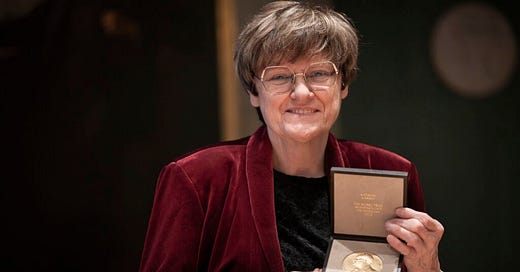How Katalin Karikó Kept Her mRNA Research Going for 35 Years
Everyone said it was impractical. Here's how she kept moving forward
35 years of people saying it was impractical. She won the 2023 Nobel Prize.
In 1995, Katalin Karikó had been working at University of Pennsylvania (UPenn) since 1985 as a professor and researcher studying mRNA.
UPenn demoted her after many grant failures.
Colleagues dismissed her research as "obsessive." She couldn't secure NIH funding, couldn't publish in top journals, couldn't build institutional support.
Two years later, she met immunologist Drew Weissman at a copy machine. Their collaboration solved mRNA's biggest problem: preventing dangerous immune reactions.
They published their findings in 2005: when custom-tailored mRNA is injected into the body, could order cells to produce any desired sequence of proteins which means we can produce vaccines and therapeutics for any infectious disease from HIV to malaria.
In retrospect, it was groundbreaking, 20 years ahead of everyone else—but, in 2005, no one took them seriously.
In 2013, UPenn removed Karikó’s lab equipment without telling her. She was forced to quit UPenn while Weissman stayed.
Her mRNA research was up in the air.
"I thought of going somewhere else, or doing something else... maybe I'm not good enough, not smart enough," — Katalin Karikó at Nobel Prize
But she had no idea her 2005 discovery would save 19.8 million lives.
“I barely cost this department anything”
This was Katalin Karikó's survival strategy. “Too cheap to get rid of”
When UPenn demoted her in 1995, she worked with the system and made the best of it.
Her salary became negligible. No post-docs. No fancy equipment. She made herself so cheap to keep that the university let her work on mRNA research even though they thought nothing would come of it.
In 1997, she met Drew Weissman who shared a passion for mRNA development but from an immunology perspective. Though Karikó wasn’t a good grant writer, Weissman was. Together, they were able to get some grant money to fund their lab but not significant amounts.
In 2005, Karikó and Weissman published a paper that would eventually get them the Nobel Prize.
From “Not Good Enough” to Nobel Prize Winner
Weissman and Karikó licensed their patent to a company called BioNTech. It gained some interest, but not enough for UPenn.
In 2013, Karikó returned to her lab to find all her belongings packed, moved, and misplaced. She was forced to leave the university.
But Karikó kept going and went to a place that valued her work rather than fight for expensive recognition at UPenn. She left UPenn for BioNTech. Her UPenn colleagues laughed saying “BioNTech doesn’t even have a website.”
This 'cheap to keep' approach wasn't just about surviving UPenn. It became Karikó's systematic method for maintaining research continuity despite institutional resistance.
“Impractical Research” saves 19.8 million Lives
The coronavirus pandemic put mRNA vaccines in the spotlight, and BioNTech was leading the charge.
She and BioNTech developed the world’s fastest vaccine response in history, from identification of (SARS-CoV-2) to global deployment in less than 12 months.
Just in the first year. the fast deployment reduced deaths by 63%, saving an estimated 19.8 million lives.
From Demoted Professor to Nobel Prize
In 2023, Katalin Karikó and Drew Weissman were awarded the Nobel Prize in Physiology or Medicine for their work on mRNA vaccines.
What can we learn from Katalin?
Her core strategy: make yourself too cheap to fire. This breaks down into three tactics she used repeatedly:
1) Focus on what you can do:
When UPenn cut her resources, Karikó fought for more funding, but still she made herself useful to the cardiology clinic with minimal cost.
2) Redefine your metrics:
Track technical progress, not just funding or recognition. Instead of following UPenn’s dollar per square footage metrics (which is the weirdest metric I’ve seen), she focused on research progress per dollar spent.
3) Focus on the Solution.
When UPenn kicked her out, she went to BioNTech allowing her to work on her research.
Overall, these questions extract directly from Karikó's 35-year survival playbook:
What is the minimum viable setup that lets you keep working on your core idea?
How can you make your research "cheap to keep" for your host institution or company?
Who are the one or two key allies you can partner with to share resources or expertise?
When you can answer these questions, you can survive institutional rejection long enough for your breakthrough research to find the right environment.
Which of these questions hits closest to your current research situation? I work with science founders navigating these exact positioning challenges - always curious to hear how others are handling institutional rejection.




